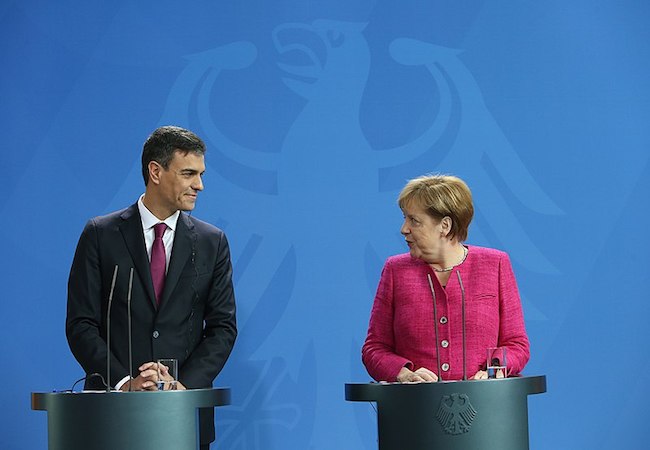What’s left of the Left: How Spain can revive Europe’s liberals

Center-left leaders have vanished from Europe’s political scene, gradually disappearing like characters in Marty McFly’s family portrait. Within the past four years, liberal leaders in France, Italy, Poland, Sweden, and Austria have flamed out with disappointing electoral defeats. Meanwhile in Germany, the once mighty Social Democratic party (SPD) resembles Fritz, the emaciated polar bear cub in Berlin’s zoo, more than a potent political force. However, one country has stemmed this right-wing tide- Spain. In Madrid, the center-left Pedro Sanchez moved into the Moncloa Palace by assuming the premiership earlier this year. Sanchez’ Spanish Socialist successes and the German left’s failures provide an interesting and useful case study comparison. Spain’s liberals have succeeded by holding true to their base’s ideology, while the German Social Democrats have suffered from attempts to move towards the center.
Sanchez has led his party into power by supporting stronger integration with Europe and weaker curbs on immigration. In contrast to Italy and other southern European nations that bar entry to migrants, Sanchez has pursued an open border policy. He has accepted North Africans crossing the Mediterranean by boat, and has also eased restrictions along Spain’s border with Morocco. Overall, 35,000 immigrants have arrived in Spain this year- more than in any other European Union country. In addition to this pro-immigration policy, Sanchez also promotes closer ties within the EU. He has explicitly asserted that he wants his government to remain “strongly European.” Sanchez selected a foreign minister, Josep Borrell, with experience working in the bureaucratic halls of Brussels who appears well equipped to collaborate with the EU. Tellingly, Sanchez visited French President Emmanuel Macron, a staunch advocate of closer European ties, on his first international trip as Prime Minister. Given the populist anti-migrant and anti-EU wave engulfing the continent, Sanchez’ policies come at great risk. Nevertheless, his decisions have proven relatively popular and have buoyed the Socialists’ approval ratings. Recent polling suggests that, if new elections took place, the Socialists would rank first with 28.8% of the vote. By tilting to the left and allying with his party’s core supporters, Sanchez has strengthened his party’s political standing.
Everything Sanchez has done right, his German counterparts have done wrong. Most prominently, SPD has failed to differentiate itself from its main rivals, the Christian Democrats. The party currently sits in a coalition government with Chancellor Angela Merkel and the Christian Democrats. SPD joined this coalition from a position of weakness, after suffering its worst election result in the post-war era. This coalition traps SPD in a seemingly no-win scenario. Given its drubbing at the polls, the party has little influence over its coalition partners, and can not effectively shape or influence administration policy. Meanwhile, by sitting in government, SPD still bears responsibility for official decisions and must bear the brunt of anti-establishment ire. SPD leader Andrea Nahles has been forced to accept more conservative immigration policy in order to remain in the coalition, a staunch contrast to Sanchez’ bold stance in Spain. Like a pinioned eagle, Nahles can neither govern nor oppose the government. This lack of direction has divided the SPD between moderates who want to remain in the coalition and stalwarts hoping to strike an independent course. Critics find no compelling reason to support the party, shrugging off the SPD with a “they’re all the same” lament.The fractured and feckless party has suffered at the polls, cratering below 10% in Bavaria’s recent election, below 20% in Hesse’s local race, and slipping to third in a projected national ballot. Since the party cannot effectively promote its core priorities, former SPD supporters have deserted in favour of the Green Party. On the whole, Nahles’ attempts at moderation and coalition have alienated supporters and stagnated the SPD.
Spanish and German liberals have chosen these different strategies in order to ward off threats from the political fringes. In Germany, the prominent extremists stand on the far-right. While Spanish right-wingers have had relatively little success, the nationalist Alternative for Germany (AfD) party has entered the Bundestag and scored well in opinion polls. As a result, Nahles and the German SPD cannot promote pro-migrant policies without backlash from the far-right. In contrast, Spain’s recent memories of dictatorship have made extremist nationalism tabú, even more so than in a historically scarred country like Germany. Spain’s successful extremist parties come from the left instead. Before Sanchez took over, the far-left Podemos party ranked ahead of the Socialists in opinion polling. Sanchez felt obligated to pursue liberal policies in order to protect his left flank. This tactic has worked thus far, as some Podemos supporters buy in to Sanchez’ messaging and may vote for the moderate-left again.
This contrast between Spain and Germany provides a useful example for other struggling center-left parties. In Germany, SPD has suffered from its failed attempt at moderation. Meanwhile Sanchez has claimed power and boosted his party’s political standing by staying true to the core ideology. Fortunately for SPD, they may soon have the opportunity to revitalize their strategy. With Chancellor Merkel’s recent decision to cede her role as party-head, the SPD could potentially unshackle themselves from the coalition. The party’s base wants to do just that- take to the hills, join the opposition, and promote a true left-wing platform. Entering coalitions with conservatives and fielding vanilla candidates has not proven a recipe for success. To regain relevance on the European stage, the left should look to Spain as a template for success.




